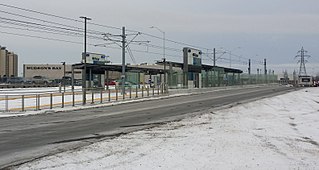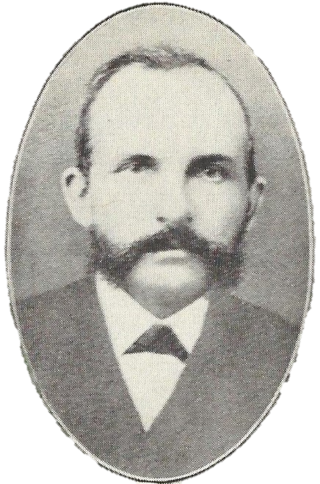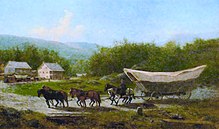
Waterloo is a city in the Canadian province of Ontario. It is one of three cities in the Regional Municipality of Waterloo. Waterloo is situated about 94 km (58 mi) west-southwest of Toronto. Due to the close proximity of the city of Kitchener to Waterloo, the two together are often referred to as "Kitchener–Waterloo", "K-W" or "The Twin Cities".

Kitchener is a city in the Canadian province of Ontario, about 100 km (62 mi) west of Toronto. It is one of three cities that make up the Regional Municipality of Waterloo and is the regional seat. Kitchener was known as Berlin until a 1916 referendum changed its name. The city covers an area of 136.86 km2, and had a population of 256,885 at the time of the 2021 Canadian census.

Cambridge is a city in the Regional Municipality of Waterloo, Ontario, Canada, located at the confluence of the Grand and Speed rivers. The city had a population of 138,479 as of the 2021 census. Along with Kitchener and Waterloo, Cambridge is one of the three core cities of Canada's tenth-largest metropolitan area.

The Regional Municipality of Waterloo is a metropolitan area of Southern Ontario, Canada. It contains the cities of Cambridge, Kitchener and Waterloo, and the townships of North Dumfries, Wellesley, Wilmot and Woolwich. Kitchener, the largest city, is the seat of government.
The Conestoga Parkway, officially the Kitchener–Waterloo Expressway, is a controlled-access highway in the Canadian province of Ontario, located entirely within the Regional Municipality of Waterloo. The 20.7-kilometre (12.9 mi) route travels east and then north through the cities of Kitchener and Waterloo, and is connected to Highway 401 via Highway 8 and King Street East. The name Conestoga Parkway is not a formal designation, but rather a local name applied to the divided expressway portions of Highway 7, Highway 8 and Highway 85 through Kitchener and Waterloo. The Ministry of Transportation of Ontario (MTO), which built and maintains the route, refers to it as the Kitchener–Waterloo Expressway.

Conestoga College Institute of Technology and Advanced Learning is a public college located in Kitchener, Ontario, Canada. Established in 1967, Conestoga serves approximately 23,000 registered students through campuses and training centres in Kitchener, Waterloo, Cambridge, Guelph, Stratford, Ingersoll and Brantford with an enrolment of 11,000 full-time students, 30,000 part-time students, and 3,300 apprenticeship students.

Grand River Transit (GRT) is the public transport operator for the Regional Municipality of Waterloo, Ontario, Canada. It operates daily bus services in the region, primarily in the cities of Kitchener, Waterloo, and Cambridge, alongside the ION rapid transit light rail system which began service on June 21, 2019.

The Township of Woolwich is a rural township in Southwestern Ontario, Canada, considered as a municipality. The Township is located in the northeast part of Waterloo Region and is made up of 10 small communities, with Elmira, Ontario the largest and St. Jacobs, Ontario the second largest. The population at the time of the 2021 Census was 26,999, up from the 2016 population of 25,006. Waterloo Region is still home to the largest population of Old Order Mennonites in Canada, particularly in the areas around St Jacobs and Elmira. They are often seen on the local roads using their traditional horse and buggy transportation; many also use horses to pull the implements in their farm fields.
The city of Berlin, Ontario, changed its name to Kitchener by referendum in May and June 1916. Named in 1833 after the capital of Prussia and later the German Empire, the name Berlin became unsavoury for residents after Britain and Canada's entry into the First World War.

Waterloo County was a county in the Canadian province of Ontario from 1853 until 1973. It was the direct predecessor of the Regional Municipality of Waterloo.
James Roos Breithaupt was a Canadian politician. He served in the Legislative Assembly of Ontario from 1967 to 1984 as a member of the Liberal Party. He won a total of five elections, and was the longest serving former Member of Provincial Parliament (MPP) for Kitchener since Canadian Confederation in 1867.
King's Highway 8, commonly referred to as Highway 8, is a provincially maintained highway in the Canadian province of Ontario. The 159.7-kilometre (99.2 mi) route travels from Highway 21 in Goderich, on the shores of Lake Huron, to Highway 5 in the outskirts of Hamilton near Lake Ontario. Before the 1970s, it continued east through Hamilton and along the edge of the Niagara Escarpment to the American border at the Whirlpool Bridge in Niagara Falls. However, the Queen Elizabeth Way (QEW) replaced the role of Highway 8 between those two cities, and the highway was subsequently transferred from the province to the newly formed Regional Municipality of Niagara in 1970. In 1998, the remaining portion east of Peters Corners was transferred to the city of Hamilton.

Doon Heritage Village, located at the Ken Seiling Waterloo Region Museum, is a picturesque 60 acre living history village that shows visitors what life was like in the Waterloo Region in the year 1914. It is located in the former Doon village, now part of Kitchener, Ontario, Canada, next to Homer Watson Park.

Doon is a suburban community and former village which is now a part of the city of Kitchener, Ontario, Canada. Doon was settled around 1800 by German Mennonites from Pennsylvania, and after 1830 by Scottish immigrants. The area is located at the confluence of Schneider Creek and the Grand River. The post office was opened in 1845. A large flour mill, oatmeal mill, distillery and sawmill were built on the Doon River over the following years. The Perine brothers established extensive linen works and flax mills near the settlement. By 1870, there was a single church, Presbyterian, a variety of tradesmen and a population of 200.

Philip Ludwig "Louis" Breithaupt was a German-born tanner and politician in Ontario, Canada. He served as mayor of Berlin from 1879 to 1880.

Fairway is a light rail station and bus station in Kitchener, Ontario, Canada. It is a stop on the Region of Waterloo's Ion rapid transit system. The station is located just off Wilson Avenue between Fairway Road and Kingsway Drive, adjacent to the Fairview Park Mall. Fairway is the southern terminus of the Ion light rail line, with adapted bus rapid transit continuing on toward Cambridge. The station opened on June 21, 2019. At the same time as the light rail launch, the existing bus terminal was moved from its current location adjacent to the Hudson's Bay store, to a new park and ride lot at the corner of Fairway and Wilson, off of the mall property.

The Preston and Berlin Street Railway was an interurban electric street railway which served the 12.68 kilometres (7.88 mi) between what was then the towns of Preston and Berlin in Midwestern Ontario, Canada. The company was formed in 1894, but lay dormant until 1900, when construction finally began. The company began operation in 1904.

Kitchener South—Hespeler is a provincial electoral district in Ontario, Canada. It was created in 2015 and has been represented in the Legislative Assembly of Ontario since the 42nd Ontario general election.

John Motz was a Canadian politician, German-language newspaper proprietor, sheriff and tailor. Born near Mühlhausen in the Province of Saxony, Prussia, he immigrated to Berlin, Canada West in 1848. In 1859, he and fellow immigrant Friedrich Rittinger founded the Berliner Journal, a German-language newspaper based in Berlin. Motz served as its editor for the next forty years before retiring in 1899, becoming the honorary sheriff of Waterloo County, a position he held until his death in 1911.
John Harold Sherk was a Canadian Mennonite minister, educator, and advocate of Christian pacifism.



















